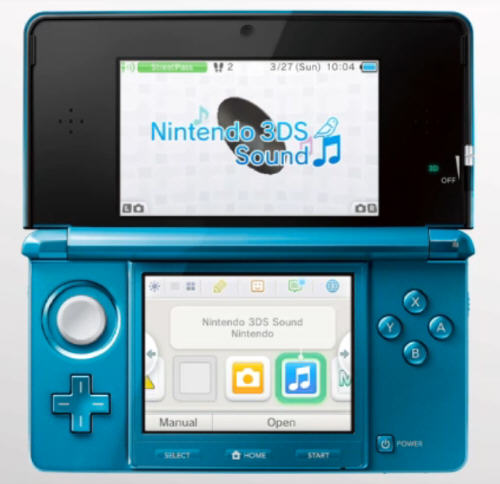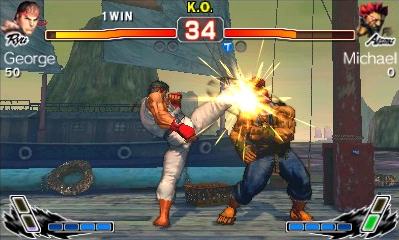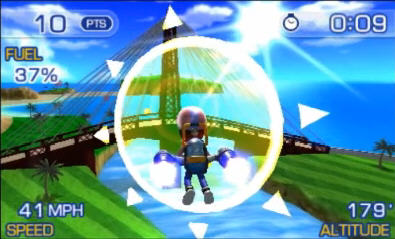The next step in Nintendo’s portable gaming family has arrived. Laura O’Brien puts the new console through its paces, especially its 3D capabilities.
Look and feel
The Nintendo 3DS’ appearance greatly resembles the Nintendo DS Lite, in terms of design and layout, but there are several key hardware features that help it stand out.
At the back, there are two outer cameras to help take 3D photos and one inner camera. Don’t expect to take beautiful images with these, as they’re all VGA cameras. Their purpose seems to be less for photography and more for other features, such as face-capturing and augmented reality.
The console includes an SD slot for memory, a volume slider, a 3D slider and a switch to turn Wi-Fi on and off. It also has a motion sensor and gyro sensor.
New additions to the gaming controls include a flat analogue stick. The stick has a thumb indent for comfort and moves smoothly in whatever direction you want it to go. The telescopic stylus is a bit weightier than the previous plastic one and can be extended in length.
The 3DS has two screens. Like with the original DS, the one at the bottom is a 3-inch touchscreen, allowing users to control it with a telescopic stylus.
The top screen, a 3.5-inch display, includes the 3DS’ most notable feature – 3D visuals.
3D
The top display doesn’t require glasses to view the full 3D effect. The 3D levels can be adjusted and turned off completely by the slider at the side of the screen.
In order to view the 3D effect, the console must be held in front of your gaze. That said, you can hold it either straight in front of you, up high or down low and it will still work, as long as your eyes are looking straight at the screen.
You can’t look at it at a slight angle from the left or right, as the image will be distorted. The distance you hold it from your face also can be a contributing factor – hold it right up against your eyes and it will blur and hold it a good way away and the effect will also diminish.
This all sounds a bit restrictive, but to be honest, the 3DS’ ‘sweet spot’ is how you’d naturally hold the console. There’s a generous amount of give provided for the distance you can hold it from your face and most people tend to keep the angle of their face in line with handheld consoles while playing them, anyway.
However, if a friend wants to look over your shoulder to see what you’re doing, they’re out of luck. If you want to show anyone anything, either give them the console or turn off the 3D.
The 3D effect is more about layering and depth than having things jump out of the screen at you. For example, in Super Street Fighter IV, the health bar appears to be on a top layer, the character models seem to be on a middle layer and the background seems to be on the bottom layer. As a result, a huge amount of visual depth is created on the top screen, making it seem like there’s a vast world located within it.
There has been a big debate in the media over whether or not the 3DS causes nausea, disorientation and headaches. Unfortunately, I can’t speak for everyone on how the visuals will affect them. Personally, at first, I found it a bit disorienting. After the initial 15 minutes, I ended up turning off the 3D and playing with 2D. However, after giving the 3D another chance, I began to get used to it and rather enjoyed it. I didn’t experience nausea and headaches, but again, that’s just me.
It’s worth pointing out that you can turn off the 3D visuals or adjust them to your liking, though those who feel the 3D is the killer app for them, this may not be ideal.
Built-in software

Another big feature of the Nintendo 3DS is Street Pass. By setting your 3DS to sleep mode and folding it over, you can exchange game data wirelessly to other 3DS owners you pass by on the street. You can adjust how much information is shared with others, too.
This is utilised is through Street Pass Quest, where, by passing by other 3DS users, you can ‘gather heroes’ and collect items to advance in a text-based quest starring your own customisable Mii characters.
It’s an interesting idea for social gaming, though it is reliant on the fact you need to pass by 3DS owners with this feature enabled. The real worth of this inclusion will take time, in order to see just how much the concept has taken off among the general public.
There’s a camera mode to allow you to take 3D pictures, though as the 3DS has VGA cameras, this seems to be more for fun than true aesthetics. It also has a basic audio programme, which lets you record sounds and add amusing filters. Both of these additions feel like you’d play with them a bit for fun, but wouldn’t get overly immersed in.
There’s also an internet browser, though it’s currently unavailable until we get a system upgrade for it.
Augmented reality
A particularly nice feature of the device was its augmented reality software. You get a few AR cards with the console and, if you scan the “?” card, it will overlay some fun 3D games over your real-world environment. For example, a 3D shooting game will grow out of the surface the card is on. By moving the 3DS around this 3D setting, you can search for difficult-to-find targets and shoot them down.
It’s an awful lot of fun, especially when you see a volcano growing out of your desk or a part of your floor rise up or a small box creature wander around your room. You can also draw things and control it around this augmented reality setting.
Along with the “?” card, you also get cards with Nintendo characters on them, such as Mario and Link from The Legend of Zelda. These are used in a photography mode, where each of the characters grow out of the cards and you can pose them to take pictures.
There is also a game built in called Face Raiders, which takes a photo of your face and sticks it onto flying enemies. It also uses augmented reality to transplant these enemies over your current surroundings. By moving the console itself around and pressing A to shoot, you can take down enemies with your face on them. It’s very enjoyable, though it will probably fuel your nightmares for a while.
While a lot of this seems pretty frivolous, I can see a lot of potential with it. Augmented reality is not exactly completely new, but it could be a nice addition to this handheld console. This built-in software is only here to show what this technology can do, and if future titles can take this and run with it, we could soon be seeing some innovative and quirky titles for the 3DS.
Gaming
With the Nintendo 3DS, I tried out Super Street Fighter IV 3D Edition and PilotWings Resort.
Super Street Fighter IV 3D Edition

This instalment of the classic fighting series was originally released for the PS3 and Xbox 360 and has been brought to the 3DS to show off the console’s hallmark 3D capabilities. Along with a traditional arcade mode, training mode and challenge modes, you can play against others online or wirelessly if they have another 3DS. The game features an impressive roster of 35 characters and it also makes allowances for newcomers and hardcore fans with its Light and Pro control options. Light maps out four complex combos as hotkeys on the bottom screen while Pro requires the player to input a long string of buttons to pull them off the good old-fashioned way. Regardless of which level you’re at, the game is still fun and challenging and is one of the strongest of the 3DS launch titles.
PilotWings Resort

This is a light flight simulator where, playing as your own customisable Mii, you can control a plane, jet pack and hang glider to navigate through challenges across the scenic WuHu Island. Mission mode offers five badges, where you must complete six challenges each to gain them as you rank up from novice to platinum. Players score points by gathering collectables, completing challenges, flying accurately and landing correctly. There’s also a free flight mode. The presentation is quite simple and pleasant to look at, with the 3D working quite well for this flight game, broadening the scope of the scenery. The gameplay’s simple to pick up but has enough depth to allow you to improve on your skills, and there’s enough to keep you coming back for another spin around the island.
Verdict
The Nintendo 3DS is certainly a unique console. The device’s challenge is to hold its own against the rising success of mobile gaming, along with fending off the more heavyweight NGP – Sony’s successor to the PSP, due out at the end of this year.
While some of its built-in software is pretty light and frothy, based on features such as the 3D visuals and augmented reality integration, it certainly stands out from the pack. And while the 3D debate rages on, I personally found that, once I adjusted to it, it was a great addition. Though what I’d love to see is a title truly take advantage of these visuals, combining it with in-game mechanics.
The real test of the Nintendo 3DS will be its gaming lineup. While the games I looked at were both great, I feel it needs something a bit stronger to make it an essential purchase. Hopefully, Nintendo will release a must-have game for the device soon, along with getting top exclusive titles from third-party developers.
The Nintendo 3DS is out now.